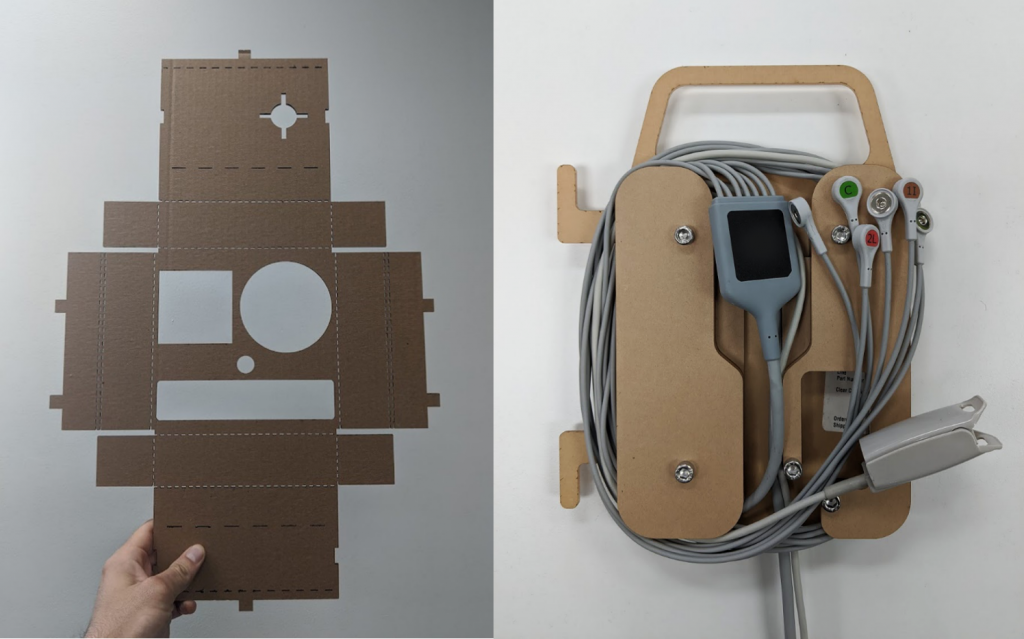
Why Laser Cutting is My New Go-To Iterative Design Tool
The design process is all about making design decisions. Whether the outcome is good or bad, the faster you can validate these decisions, the better your design becomes because you are iterating and learning. My new favorite tool to iterate is our laser cutting machine.
I must admit that before joining StarFish, laser cutting was not one of my “go-to” tools as I found it difficult to dial in precise tolerances.
Even something as thin as a laser beam removes some material (the kerf) from the part being cut. The amount of material removed is affected by many variables. Type of material, thickness of material, speed of the laser and the laser power all need to be tested and dialed in to accurately predict the amount of kerf. When working with an external vendor this can lead to expensive and time-consuming iteration spins. However, having one of these tools in-house for ideation allows the process to be rapid and efficient.
Compared to my previous “go-to” tool, the increasingly popular FDM 3D printing process, I have found several advantages to using laser cutting as a rapid ideation tool. I really like the large range of materials available: wood, plywood, leather, textile, adhesive, acrylic, polystyrene, silicone, cardboard, paper and metal.
For laser cutting, you can create your design in a CAD sketch or with graphic software, then export it as a DXF and import it into the laser cutter. From there you define the laser power, speed, and place your material in the machine. In a matter of minutes, you have your design in front of you, ready for a review. This quick turnaround allows designers to make and test several iterations in a matter of hours – which is ideal in a fast-paced environment.
From a single object to a small batch of production units, the laser cutter has allowed us to rapidly ideate, validate and improve our medical device concept designs. Figure 2 is an example of quick iteration spins. I used cardboard to mimic the foam insert I was working on. The goal was to find the right fit for our device in the foam insert and also to judge how easy it was to remove the device. After I cut the first concept (the bottom one), I noticed there was not enough room to grab the device, so I increased the side recesses. I also cut 3 different widths 98mm, 99mm and 100mm to find the perfect fit.

In fact, laser cutting has proved so versatile and efficient that I have used it for a variety of projects over the past year including:
- Packaging trays
- Enclosures for PCBs and electronics
- All sort of jigs
- Adhesives (lots of them)
- Logo stamps
- Surgical aids
- Rulers
- Logo entrance sign
- Packaging sleeves
- Clear film protection
- Full prototype of a cable management feature. By bolting several sheets of acrylic together and cutting them strategically, you can create pockets and hooks to judge the usability of the cable management feature you are working on.
- Mimic foam trays with cardboard
- Motor mounting plates
- Cutting channels in a glass cartridge


All of the examples I have shown suggest that you can only create flat patterns with sharp corners, but there is more to it. My coworker is currently working on a wooden design that requires curved panels. In order to do this, we used a kerf pattern where we want bends located. The kerf pattern is made of lots of small cuts next to each other in order to allow the material to bend. As a bonus you can easily engrave the part numbers of the parts you are working on, add branding or even usability instructions directly on the part. Handy.
One of the main uses of laser cutting in product design is for enclosures to hold PCBs or parts in place. A laser cutting machine allows designers to create a 3-dimensional box made of 2-dimensional design elements (sheets of material). Using screws, dowels or castle features on the edges, you can build an enclosure really quickly and cost efficiently.
To give you an idea, in 15 minutes you can have a 5x5x5in box cut and assembled whereas it would take over an hour to 3D print the same box. Acrylic is my recommendation if you are looking to build a strong enclosure with a laser cutter, but you can also use basswood. To add a bit of fun to your project, buy clear acrylic sheet with a tint of color, or even diffuse LED lights on the edge of a clear acrylic. A good source for box inspiration is the Raspberry Pie Box by Adafruit.

Summary
Though a laser cutting machine with a large bed may seem like a substantial investment, the amount of time (and money) saved during the design process is considerable. Designing and cutting on the go allows me to stay in rhythm with my design decisions. I definitely recommend buying a laser cutting machine. It is fun and useful!
Kevin Meric is an Industrial Designer at StarFish Medical. He studied Mechanical Engineering at Université de Technologie de Belfort-Montbéliard and then transitioned to Industrial Design through internships in China, U.S. and Canada.
Images: StarFish Medical
